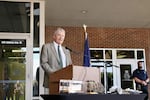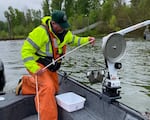The DNA lab results came back Monday.
“The initial phone call was a bit of a shock,” said Nic Zurfluh, the Idaho State Department of Agriculture bureau chief for invasive species. “But this is what we plan for.”
The call confirmed that routine water sampling had captured the larval form of the quagga mussel — only visible under a microscope — freely floating in the Snake River by Twin Falls.

Sgt. Pam Taylor of the Washington Dept. of Fish and Wildlife displays invasive quagga mussels during a demonstration of a boat inspection for reporters, Tuesday, Feb. 25, 2020, at a boat launch in Olympia, Wash. Environmental and other agencies seek to stop the spread of invasive mussels because they can clog piping and mechanical systems of industrial plants, utilities, locks and dams.
Ted S. Warren / AP
The species is one of the most invasive in the U.S., and its invasion into the Pacific Northwest has long been dreaded.
By Tuesday, the popular waterfront park in the Snake River Canyon was shut down and nearby lakes and river access points were closed to recreationists with boats, kayaks, paddle boards and canoes. Idaho Gov. Brad Little called two press conferences.
“The what if — what if it’s unconstrained — is going to leave a huge mark on this valley and the state of Idaho for a long, long time,” Little said in Twin Falls.

Gov. Brad Little called the discovery of quagga mussel in the Snake River a "potential crisis."
Rachel Cohen/Boise State Public Radio
Adult quagga mussels are smaller than a human thumbnail. A single female can produce more than one million eggs in a year. Within a month of hatching, they latch onto surfaces, quickly coating and clogging irrigation pipes, drinking water intakes and hydropower equipment.
Native to Eastern Europe, the quagga and similarly invasive zebra mussels had already impacted all major river basins in the U.S. The Columbia River Basin, spanning the Pacific Northwest, was the last holdout.
“It’s a huge deal,” said Blaine Parker, an invasive species biologist for the Columbia River Inter-tribal Fish Commission. “We are no longer zebra mussel and quagga mussel free.”
“It will change what it means to be a Pacific Northwesterner”
The discovery’s implications extend beyond Idaho, as the Snake River flows into the Columbia River system, shared by the region’s tribes and the states of Washington and Oregon.

The Washington Department of Fish and Wildlife sampled for mussels and other invasive species on the Columbia River in 2022. No invasive quagga or zebra mussels have been found Washington’s waters, including in the Snake River.
Courtesy of Washington Department Of Fish And Wildlife
The invasive mussel is particularly feared for the substantial damage it can inflict on infrastructure. Both Idaho and Washington estimate a price tag of hundreds of millions of dollars per year to manage a fully-established infestation, which would include maintenance work to irrigated agriculture and hydropower systems — both critical for the Northwest. However, some of these costs would likely be passed on to ratepayers.
The projected dollar figures are not the only cause for concern; the mussels have demonstrated their ability to fundamentally alter ecosystems.
“The key is that when quagga and zebra mussels invade a system, they can turn the ecology on its ear,” Parker said.
The filter feeders strip out plankton from the water, disrupting the food web for native fish like trout and salmon. Parker said on top of changing the habitat, they could impede salmon on their migration between the ocean and inland spawning grounds.
“The very presence of mussels coating fish ladders, fishways and juvenile bypass systems, affect the ability of those systems to safely and efficiently pass juvenile fish and adult fish back and forth through the system,” he said.
These reasons have motivated Western states to keep the invasive mussels out of the region. Since setting up its program in 2009, Idaho has inspected more than one million boats, which are often suspected of introducing the species to water bodies. Just last year, the state intercepted 36 boats carrying mussels.
Justin Bush, the aquatic invasive species policy coordinator for Washington’s Department of Fish and Wildlife, said the prevention work has been delaying a somewhat inevitable infestation.
“At some point, it’s a question of ‘if,’ it’s not ‘when,’” he said. “But, if we can take more action now, ‘when’ won’t be today.”
On Tuesday, after learning about the discovery of the quagga mussel larvae In Idaho, Washington began pushing its aquatic invasive monitoring and boat inspection crews to the southeastern part of the state, where the Snake River crosses the border with Idaho.
Any delay of the mussel’s arrival is vital, Bush said. He imagines they would bring new restrictions on boating and recreation.
“It’s going to impact every portion of our lives,” Bush said. “It will change what it means to be a Pacific Northwesterner.”
The hunt for the quagga mussel
In place of tourists and boaters at the waterfront in Twin Falls this week are scientists, searching for the baby mussels floating in the water.
“The goal is, hunt out for the quagga mussel,” said Zurfluh, the invasive species bureau chief for the Idaho State Department of Agriculture.
About 20 ISDA staff were spread out on the river in boats and kayaks collecting water samples in plankton nets that look like coffee filters. Divers were investigating deeper under the surface.
They’re trying to figure out how many of the larvae, called veligers, there are, and how far they’ve gone. So far, sampling upstream and downstream of this stretch of the river hasn’t turned anything up.
“That’s what we’re hopeful, is that it is contained within this area,” Zurfluh said.
The veligers could have sneaked into the river on their own by, for example, hitching a ride in the water sitting in a kayak hull. That could provide an opportunity for Idaho officials to contain the population before the mussels settle down.
The other possibility, of course, is that the veligers are offspring of adult quagga mussels that have already taken up residence. But, the researchers haven’t yet found a cluster of adults.
In the meantime, the state is scrambling to decontaminate all watercraft that have been in this stretch of the river in the last month. It’s set up two locations in Twin Falls for people to bring boats for a “hot wash.”
The Idaho Department of Fish and Game also closed several popular fishing and waterfowl hunting spots along the river. Scientists with the Bureau of Reclamation and Idaho Power, which both operate dams nearby, are out doing their own monitoring for veligers and are ready to assist Idaho with dive teams and remotely operated submersibles.
The results from sampling over the next few weeks could reveal the scope of the problem and offer potential solutions.
“It’s a crisis, no doubt,” Zurfluh said. “But it’s still a very manageable crisis.”
Find reporter Rachel Cohen on Twitter @racheld_cohen
Copyright 2023 Boise State Public Radio